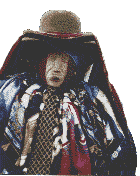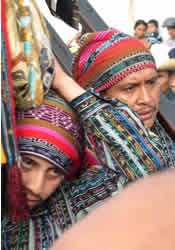 |
|
SantiagoAround the Lake Atitlán Today History Weaving Art Mayan Religion The Cofradias Maximon Semana Santa The Yearly CycleFeria Social Projects Local Business Tienda Santiago Links Photo Archive 2005 Disaster Music Festival Virtual Maximon
Lealo en Español |
The main purpose of Mayan Religious practices is to ensure that the Sun, stars, moon, and planets continue on their paths. In the greater scheme of things man has his part: through following a rigid schedule of rituals he can help to keep the gears greased. If someone doesn't´t do the rituals on the proper time and in the correct manner the cycle will be broken and the world will end. The Cofradias or Brotherhoods provide this function in Santiago.
Although In Santiago Atitlan the cofradias were probably in full operation
by 1585 (Orellana 1975). By organizing the newly converted Indians into eight
or ten cofradias, each under the patronage of a Catholic |
|
This process was facilitated by the congruence of Catholic and Maya patterns, such as the solar orientation of both calendars and the great number of holy personages venerated in both cults. The statues of the Saints in the church and the cofradias were easily identified with the lords and Guardian-spirits of the Tzutuhil pantheon, so that today little remains of the Catholic identity of the Saints except their names and the calendar date of their feast days. The cofradias, which had functioned as auxiliary to the Church, are now of equal or greater importance in the Indian religion than the Church. The primary ritual was transferred from the Church to center in the cofradias, and is performed not by Catholic priests but by native shamans and prayer makers. Jesus, who in Catholic belief, is the divine God-man who surpasses all the Saints in dignity and power, is one of the many ancestral gods of the Tzutuhil pantheon. Each cofradia has up to fifteen official members who volunteer their service for a year at a time. In Atitlan, cofradia service is a path to becoming a Principal or respected elder in one's maturity. At one time the Indian government operated through the cofradia system. Official cofradia members and their duties: Men: The alcalde or mayor of the cofradia, who accepts the
statues of the saints and the other cofradia furniture into a house in his
sitio for a year. The first to sixth cofrades are officials of the cofradia who are given special duties in the care of ritual objects and feast day celebrations, the ritual serving of liquor to members and visitors, and similar tasks. Women: the Xo or mayoress who is the wife of the alcalde, theoretically
equal to him in power, and the leader of the women members of the cofradia; Two cofradias, San Juan and Santa Cruz, have a special shaman attached to them who is responsible for the rituals of the cofradia patron. These are the nabeysil of the cofradia San Juan, and the telinel of the cofradia Santa Cruz. Semi-official members of the cofradias are the dancers of the yearly "Deer dance" and the "Dance of the Conquest, " and the musicians, a flautist and drummer, and the musical groups who sing the songs of the Face of the Earth. The townspeople who associate themselves with the cofradias do so, not by any formal membership, but by attending important calendric rituals and frequenting the cofradia with shamans and prayer makers for special needs. Anyone may, With the approval of the principales or elders, serve one or more times in an official capacity in one of the cofradias. The different power bundles are maintained by different cofradias; until recently Maximon was always at the cofradia Santa Cruz . Since 1999 the cofradias have started to take turns taking care of the Rilaj Mam. |

 set up by the Spanish priests to promote Christian ideals they were
soon subverted to the Native religion. They are each named for the saint
or deity that they are dedicated to. The process of becoming a full fledged
brother involves many steps and has traditionally been the way for a man
to prove his worth to the village and the gods. In the past the government
of the village was directed through the cofradia system; the leaders of the
most powerful cofradias also acted as judges and decision makers. Since the
time of Ubico this system was eliminated and the government of the town went
over to elected officials. The Cofradias maintain influence because they
are the people who are in charge of the different power bundles that live
in Santiago.The following is from Linda O´brien "Songs of the face
of the Earth"The cofradias were brought to Guatemala by the early Franciscan
missionaries from Spain, where they had existed since the Middle Ages. Originally
a sort of guild system, they in time evolved into religious confraternities
or brotherhoods, each responsible for the care of an image of the patron
saint and the celebration of his feast day.
set up by the Spanish priests to promote Christian ideals they were
soon subverted to the Native religion. They are each named for the saint
or deity that they are dedicated to. The process of becoming a full fledged
brother involves many steps and has traditionally been the way for a man
to prove his worth to the village and the gods. In the past the government
of the village was directed through the cofradia system; the leaders of the
most powerful cofradias also acted as judges and decision makers. Since the
time of Ubico this system was eliminated and the government of the town went
over to elected officials. The Cofradias maintain influence because they
are the people who are in charge of the different power bundles that live
in Santiago.The following is from Linda O´brien "Songs of the face
of the Earth"The cofradias were brought to Guatemala by the early Franciscan
missionaries from Spain, where they had existed since the Middle Ages. Originally
a sort of guild system, they in time evolved into religious confraternities
or brotherhoods, each responsible for the care of an image of the patron
saint and the celebration of his feast day.  Cofradias became very popular
in Spain during the sixteenth and seventeenth centuries as instruments of
the counter reformation. Transferred to the New World, they became tools
for the propagation of the new faith to the Indians.
Cofradias became very popular
in Spain during the sixteenth and seventeenth centuries as instruments of
the counter reformation. Transferred to the New World, they became tools
for the propagation of the new faith to the Indians.  Saint (San Juan
Bautista, Santiago, Santa Maria del Rosario; or mystery(Santisimo Sacramento.
Santa Cruz) each with its set of officials responsible for the group's activities,
the friars simplified the task of carrying out the liturgical and para-liturgical
celebrations of the saints' days and mysteries regularly occurring in the
cycle of the Church year. Cofrades, as cofradia members are called, probably
also served as the choir, participating with the friars in the chanting of
the Divine Office and the Mass, They were responsible for the regular
care of the Church and its numerous statues, the cleaning and replacement
of candles and similar services. The period of intense post-conquest missionary activity was followed by
two and a half centuries of relative abandonment by the clergy, during which
time the interpretation of Catholic ritual and symbolism in terms of Tzutuhil
beliefs and cosmology was accomplished in the cofradias.
Saint (San Juan
Bautista, Santiago, Santa Maria del Rosario; or mystery(Santisimo Sacramento.
Santa Cruz) each with its set of officials responsible for the group's activities,
the friars simplified the task of carrying out the liturgical and para-liturgical
celebrations of the saints' days and mysteries regularly occurring in the
cycle of the Church year. Cofrades, as cofradia members are called, probably
also served as the choir, participating with the friars in the chanting of
the Divine Office and the Mass, They were responsible for the regular
care of the Church and its numerous statues, the cleaning and replacement
of candles and similar services. The period of intense post-conquest missionary activity was followed by
two and a half centuries of relative abandonment by the clergy, during which
time the interpretation of Catholic ritual and symbolism in terms of Tzutuhil
beliefs and cosmology was accomplished in the cofradias. This house serves as a chapel of ‘the ancestors and saints
whose images are housed there, the focus of calendric festivities of music
and dancing, a place of prayer open to shamans and others who wish to honor
the saints and ancestors or perform rituals at any time of day or night,
and a meeting place for the cofrades.
This house serves as a chapel of ‘the ancestors and saints
whose images are housed there, the focus of calendric festivities of music
and dancing, a place of prayer open to shamans and others who wish to honor
the saints and ancestors or perform rituals at any time of day or night,
and a meeting place for the cofrades. the first to sixth tixels are the official women members of the cofradia
whose duties include cooking for and serving the cofrades at appointed times
of gathering, and attendance at cofradia functions.
the first to sixth tixels are the official women members of the cofradia
whose duties include cooking for and serving the cofrades at appointed times
of gathering, and attendance at cofradia functions.